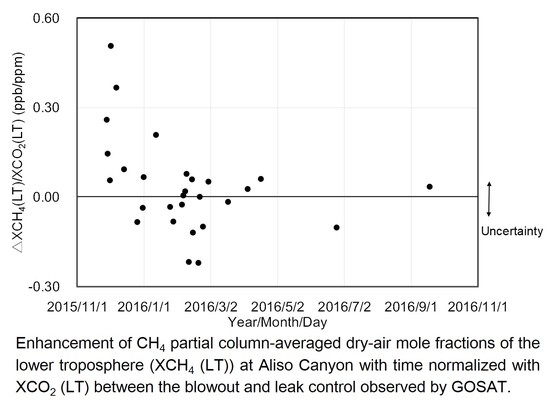Detection of Methane Emission from a Local Source Using GOSAT Target Observations
Abstract
:1. Introduction
2. Data Acquisition and Analytical Dataset for Local Emission Detection
2.1. GOSAT Observations
2.2. Targeting Point Sources
2.3. Derivation of CH4 Partial Column-averaged Density in the Lower Troposphere
3. Detectivity Study for Detecting Local Emission
3.1. Detectivity and Site Selection
3.2. Trend Analysis for the Gas Leak in Aliso Canyon
4. Reducing Uncertainties in the Local Flux Estimation
5. Conclusions
Author Contributions
Funding
Acknowledgments
Conflicts of Interest
Appendix A. Background Subtraction, Normalization, and Filtering Processes
Appendix A.1. Background Subtraction Using Reference Point Data

Appendix A.2. Normalization Process

Appendix A.3. Filtering with Wind Direction
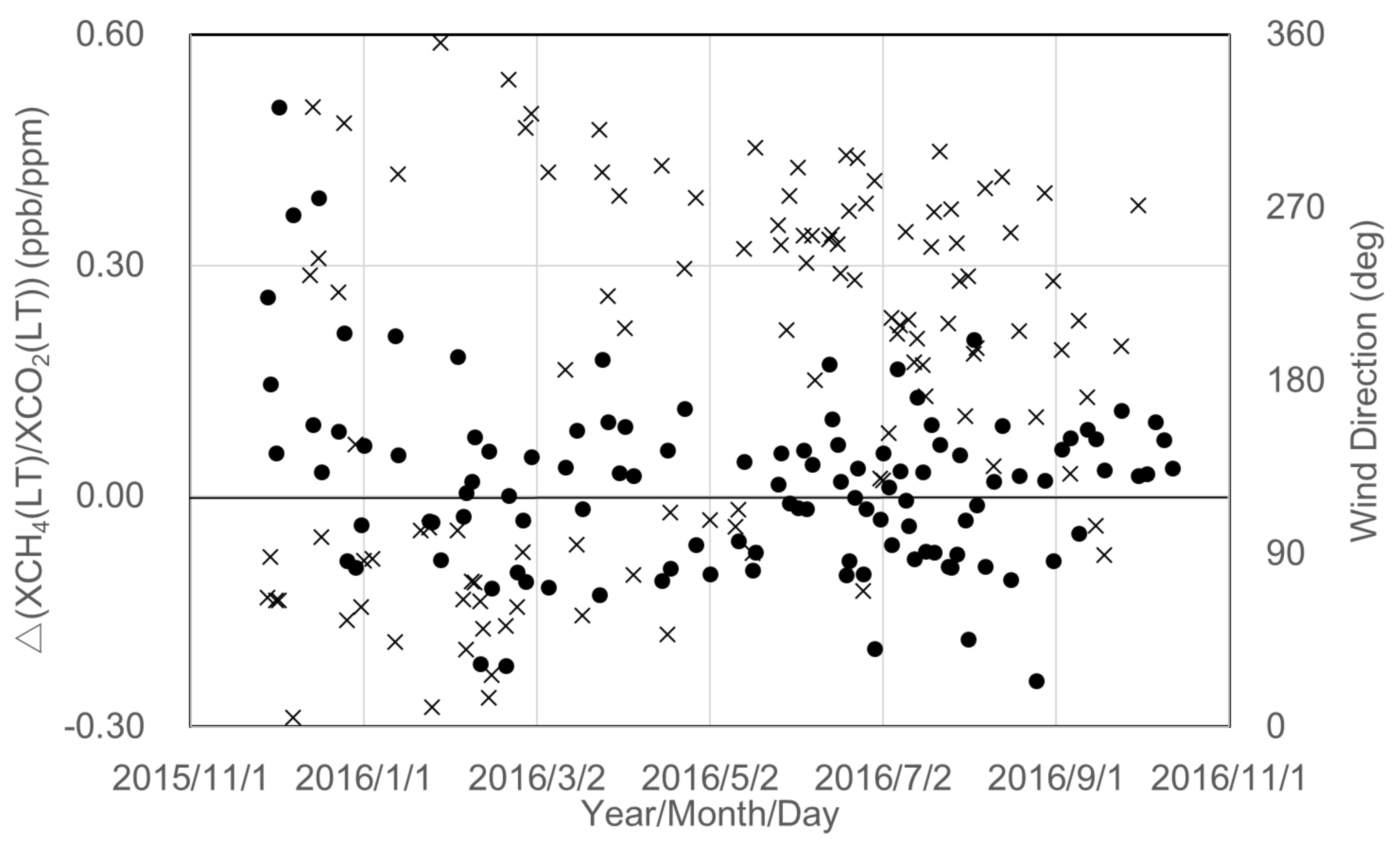
References
- Thompson, D.R.; Thorpe, A.K.; Frankenberg, C.; Green, R.O.; Duren, R.; Guanter, L.; Hollstein, A.; Middleton, E.; Ong, L.; Ungar, S. Space-based remote imaging spectroscopy of the Aliso Canyon CH4 superemitter. Geophys. Res. Lett. 2016, 43, 6571–6578. [Google Scholar] [CrossRef] [Green Version]
- Frankenberg, C.; Thorpe, A.K.; Thompson, D.R.; Hulley, G.; Kort, E.A.; Vance, N.; Borchardt, J.; Krings, T.; Gerilowski, K.; Sweeney, C.; et al. Airborne methane remote measurements reveal heavy-tail flux distribution in Four Corners region. Proc. Natl. Acad. Sci. USA 2016, 113, 9734–9739. [Google Scholar] [CrossRef] [Green Version]
- Duren, R.M.; Thorpe, A.K.; Foster, K.T.; Rafiq, T.; Hopkins, F.M.; Yadav, V.; Bue, B.D.; Thompson, D.R.; Conley, S.; Colombi, N.K.; et al. California’s methane super-emitters. Nature 2019, 575, 180–184. [Google Scholar] [CrossRef] [PubMed] [Green Version]
- Jacob, D.J.; Turner, A.J.; Maasakkers, J.D.; Sheng, J.; Sun, K.; Liu, X.; Chance, K.; Aben, I.; McKeever, J.; Frankenberg, C. Satellite observations of atmospheric methane and their value for quantifying methane emissions. Atmos. Chem. Phys. 2016, 16, 14371–14396. [Google Scholar] [CrossRef] [Green Version]
- Buchwitz, M.; de Beek, R.; Burrows, J.P.; Bovensmann, H.; Warneke, T.; Notholt, J.; Meirink, J.F.; Goede, A.P.H.; Bergamaschi, P.; Körner, S.; et al. Atmospheric methane and carbon dioxide from SCIAMACHY satellite data: Initial comparison with chemistry and transport models. Atmos. Chem. Phys. 2005, 5, 941–962. [Google Scholar] [CrossRef] [Green Version]
- Crisp, D.; Atlas, R.M.; Bréon, F.-M.; Brown, L.R.; Burrows, J.P.; Ciais, P.; Connor, B.J.; Doney, S.C.; Fung, I.Y.; Jacob, D.J.; et al. The Orbiting Carbon Observatory (OCO) mission. Adv. Space Res. 2004, 34, 700–709. [Google Scholar] [CrossRef] [Green Version]
- Yang, D.X.; Liu, Y.; Cai, Z.N.; Chen, X.; Yao, L.; Lu, D.R. First global carbon dioxide maps produced from TanSat measurements. Adv. Atmos. Sci. 2018, 35, 621–623. [Google Scholar] [CrossRef]
- Varon, D.J.; McKeever, J.; Jervis, D.; Maasakkers, J.D.; Pandey, S.; Houweling, I.; Aben, I.; Scarpelli, T.; Jacob, D.J. Satellite discovery of anomalously large methane point sources from oil/gas production. Geophys. Res. Lett. 2019, 46, 13507–13516. [Google Scholar] [CrossRef] [Green Version]
- Veefkind, J.; Aben, I.; McMullan, K.; Förster, H.; de Vries, J.; Otter, G.; Claas, J.; Eskes, H.; de Haan, J.; Kleipool, Q.; et al. TROPOMI on the ESA Sentinel-5 precursor: A GMES mission for global observations of the atmospheric composition for climate, air quality and ozone layer applications, the Sentinel missions—New opportunities for science. Remote Sens. Environ. 2012, 120, 70–83. [Google Scholar] [CrossRef]
- Eldering, A.; Kaki, S.; Crisp, D.; Gunson, M.R. The OCO-3 Mission; The American Geophysical Union Fall Meeting: San Francisco, CA, USA, 2013. [Google Scholar]
- Kuze, A.; Suto, H.; Nakajima, M.; Hamazaki, T. Thermal and near infrared sensor for carbon observation Fourier-transform spectrometer on the Greenhouse Gases Observing Satellite for greenhouse gases monitoring. Appl. Opt. 2009, 48, 6716–6733. [Google Scholar] [CrossRef]
- Kuze, A.; Suto, H.; Shiomi, K.; Kawakami, S.; Tanaka, M.; Ueda, Y.; Deguchi, A.; Yoshida, J.; Yamamoto, Y.; Kataoka, F.; et al. Update on GOSAT TANSO-FTS performance, operations, and data products after more than 6 years in space. Atmos. Meas. Tech. 2016, 9, 2445–2461. [Google Scholar] [CrossRef] [Green Version]
- Maddy, E.S.; Barnet, C.D.; Goldberg, M.; Sweeney, C.; Liu, X. CO2 retrievals from the Atmospheric Infrared Sounder: Methodology and validation. J. Geophys. Res. 2008, 113, D11301. [Google Scholar] [CrossRef] [Green Version]
- Beer, R.; Glavich, T.A.; Rider, D.M. Tropospheric emission spectrometer for the Earth Observing System’s Aura Satellite. Appl. Opt. 2001, 40, 2356–2367. [Google Scholar] [CrossRef] [PubMed]
- Clerbaux, C.; Boynard, A.; Clarisse, L.; George, M.; Hadji-Lazaro, J.; Herbin, H.; Hurtmans, D.; Pommier, M.; Razavi, A.; Turquety, S.; et al. Monitoring of atmospheric composition using the thermal infrared IASI/MetOp sounder. Atmos. Chem. Phys. 2009, 9, 6041–6054. [Google Scholar] [CrossRef] [Green Version]
- Tobin, D.; Tobin, D.; Revercomb, H.; Knuteson, R.; Taylor, J.; Best, F.; Borg, L.; DeSlover, D.; Martin, G.; Buijs, H.; et al. Suomi-NPP CrIS radiometric calibration uncertainty. J. Geophys. Res. Atmos. 2013, 118, 10589–10600. [Google Scholar] [CrossRef]
- Turner, A.J.; Jacob, D.J.; Wecht, K.J.; Maasakkers, J.D.; Biraud, S.C.; Boesch, H.; Bowman, K.W.; Deutscher, N.M.; Dubey, M.K.T.; Griffith, D.W.; et al. Estimating global and North American methane emissions with high spatial resolution using GOSAT satellite data. Atmos. Chem. Phys. 2015, 15, 7049–7069. [Google Scholar] [CrossRef] [Green Version]
- Sheng, J.-X.; Jacob, D.J.; Turner, A.J.; Maasakkers, J.D.; Benmergui, J.; Bloom, A.A.; Arndt, C.; Gautam, R.; Zavala-Araiza, D.; Boesch, H.; et al. 2010–2016 methane trends over Canada, the United States, and Mexico observed by the GOSAT satellite: Contributions from different source sectors. Atmos. Chem. Phys. 2018, 18, 12257–12267. [Google Scholar] [CrossRef] [Green Version]
- Wunch, D.; Toon, G.C.; Blavier, J.-F.L.; Washenfelder, R.A.; Notholt, J.; Connor, B.J.; Griffith, D.W.T.; Sherlock, V.; Wennberg, P.O. The Total Carbon Column Observing Network. Philos. Trans. R. Soc. A 2011, 369, 2087–2112. [Google Scholar] [CrossRef] [Green Version]
- Butz, A.; Guerlet, S.; Hasekamp, O.; Schepers, D.; Galli, A.; Aben, I.; Frankenberg, C.; Hartmann, J.-M.; Tran, H.; Kuze, A.; et al. Toward accurate CO2 and CH4 observations from GOSAT. Geophys. Res. Lett. 2011, 38, L14812. [Google Scholar] [CrossRef] [Green Version]
- Guerlet, S.; Butz, A.; Schepers, D.; Basu, S.; Hasekamp, O.P.; Kuze, A.; Yokota, T.; Blavier, J.-F.; Deutscher, N.M.; Griffith, D.W.T.; et al. Impact of aerosol and thin cirrus on retrieving and validating XCO2 from GOSAT shortwave infrared measurements. J. Geophys. Res. Atmos. 2013, 118, 4887–4905. [Google Scholar] [CrossRef] [Green Version]
- Schepers, D.; Guerlet, S.; Butz, A.; Landgraf, J.; Frankenberg, C.; Hasekamp, O.; Blavier, J.F.; Deutscher, N.M.; Griffith, D.W.T.; Hase, F.; et al. Methane retrievals from Greenhouse Gases Observing Satellite (GOSAT) shortwave infrared measurements: Performance comparison of proxy and physics retrieval algorithms. J. Geophys. Res. 2012, 117, D10307. [Google Scholar] [CrossRef] [Green Version]
- Crisp, D.; Fischer, B.M.; O’Dell, C.; Frankenberg, C.; Basilio, R.; Bösch, H.; Brown, L.R.; Castano, R.; Connor, B.; Deutscher, N.M.; et al. The ACOS XCO2 retrieval algorithm, Part II: Global XCO2 data characterization. Atmos. Meas. Tech. 2012, 5, 1–21. [Google Scholar] [CrossRef]
- Yoshida, Y.; Kikuchi, N.; Morino, I.; Uchino, O.; Oshchepkov, S.; Bril, A.; Saeki, T.; Schutgens, N.; Toon, G.C.; Wunch, D.M.; et al. Improvement of the retrieval algorithm for GOSAT SWIR XCO2 and XCH4 and their validation using TCCON data. Atmos. Meas. Tech. 2013, 6, 1533–1547. [Google Scholar] [CrossRef]
- Parker, R.; Boesch, H.; Cogan, A.; Fraser, A.; Feng, L.; Palmer, P.I.; Messerschmidt, J.; Deutscher, N.; Griffith, D.W.T.; Notholt, J.; et al. Methane observations from the Greenhouse Gases Observing SATellite: Comparison to ground–based TCCON data and model calculations. Geophys. Res. Lett. 2011, 38, L15807. [Google Scholar] [CrossRef] [Green Version]
- Saitoh, N.; Kimoto, S.; Sugimura, R.; Imasu, R.; Kawakami, S.; Shiomi, K.; Kuze, A.; Machida, T.; Sawa, Y.; Matsueda, H. Algorithm update of the GOSAT/TANSO-FTS thermal infrared CO2 product (version 1) and validation of the UTLS CO2 data using CONTRAIL measurements. Atmos. Meas. Tech. 2016, 9, 2119–2134. [Google Scholar] [CrossRef] [Green Version]
- Kikuchi, N.; Yoshida, Y.; Uchino, O.; Morino, I.; Yokota, T. An advanced retrieval algorithm for greenhouse gases using polarization information measured by GOSAT TANSO-FTS SWIR I: Simulation study. J. Geophys. Res. Atmos. 2016, 121. [Google Scholar] [CrossRef] [Green Version]
- Kikuchi, N.; Kuze, A.; Kataoka, F.; Shiomi, K.; Hashimoto, M.; Suto, H.; Knuteson, R.; Iraci, L.; Yates, E.; Gore, W.; et al. Three-Dimensional Distribution of Greenhouse Gas Concentrations over Megacities Observed by GOSAT; The American Geophysical Union Fall Meeting: San Francisco, CA, USA, 2017. [Google Scholar]
- Yates, E.L.; Lowenstein, M.; Iraci, L.T.; Tadic, J.; Sheffner, E.J.; Schiro, K.; Kuze, A. Carbon dioxide and methane at a desert site—A case study at Railroad Valley playa, Nevada, USA. MDPI Atmos. 2011, 2, 702–714. [Google Scholar] [CrossRef] [Green Version]
- Tadic, J.M.; Lowenstein, M.; Frankenberg, C.; Butz, A.; Roby, M.; Iraci, L.T.; Yates, E.L.; Gore, W.; Kuze, A. A comparison of in-situ aircraft measurements of carbon dioxide and methane to GOSAT data measured over Railroad Valley playa, Nevada, USA. IEEE Trans. Geosci. Remote Sens. 2014, 52, 7764–7774. [Google Scholar] [CrossRef]
- Tanaka, T.; Yates, E.; Iraci, L.; Johnson, M.S.; Gore, W.; Tadic, J.M.; Loewenstein, M.; Kuze, A.; Frankenberg, C.; Butz, A.; et al. Two year comparison of airborne measurements of CO2 and CH4 with GOSAT at Railroad Valley, Nevada. IEEE Trans. Geosci. Remote Sens. 2016, 54, 4367–4375. [Google Scholar] [CrossRef]
- Iraci, L.T.; Yates, E.L.; Parworth, C.; Kuze, A.; Kikuchi, N.; Kataoka, F.; Shiomi, K.; Suto, H.; Kulawik, S.S.; Basu, S. Vertical Profiles of Greenhouse Gases Collected over Land and Water in the Western US in Support of Partial Column Validation Efforts; A43R-3147; AGU Fall Meeting: San Francisco, CA, USA, 2019. [Google Scholar]
- Kataoka, F.; Knuteson, R.O.; Kuze, A.; Shiomi, K.; Suto, H.; Yoshida, J.; Kondo, S.; Saitoh, N. Calibration, Level 1 Processing and Radiometric Validation for TANSO-FTS TIR on GOSAT. IEEE Trans. Geosci. Remote Sens. 2019, 57, 3490–3500. [Google Scholar] [CrossRef]
- Bedford, B. Free flight time for projects in atmospheric sciences. EOS Earth Space Sci. News 2018, 99. [Google Scholar] [CrossRef]
- Conley, S.; Franco, G.; Faloona, I.; Blake, D.R.; Peischl, J.; Ryerson, T.B. Methane emissions from the 2015 Aliso Canyon blowout in Los Angeles, CA. Science 2016, 351, 1317–1320. [Google Scholar] [CrossRef] [PubMed] [Green Version]
- Weather Underground. Available online: https://www.wunderground.com/ (accessed on 30 December 2019).
- Skamarock, W.C.; Klemp, J.B.; Dudhia, J.; Gill, D.O.; Barker, D.M.; Duda, M.G.; Huang, X.-Y.; Wang, W.; Powers, J.G. A description of the advanced research WRF Version 3. NCAR Tech. Note NCAR/TN-475+STR 2008, 113. [Google Scholar] [CrossRef]
- Hu, H.; Landgraf, J.; Detmers, R.; Borsdorff, T.; Aan de Brugh, J.; Aben, I.; Butz, A.; Hasekamp, O. Toward global mapping of methane with TROPOMI: First results and intersatellite comparison to GOSAT. Geophys. Res. Lett. 2018, 45. [Google Scholar] [CrossRef]
- Kuze, A.; Suto, H. Imaging Spectrometer with an Agile Pointing System to Quantify Global and Regional Greenhouse Gas Fluxes and Monitor Localized Emission Sources. Trans. JSASS Aerosp. Tech. Jpn. 2018, 16, 147–151. [Google Scholar] [CrossRef]
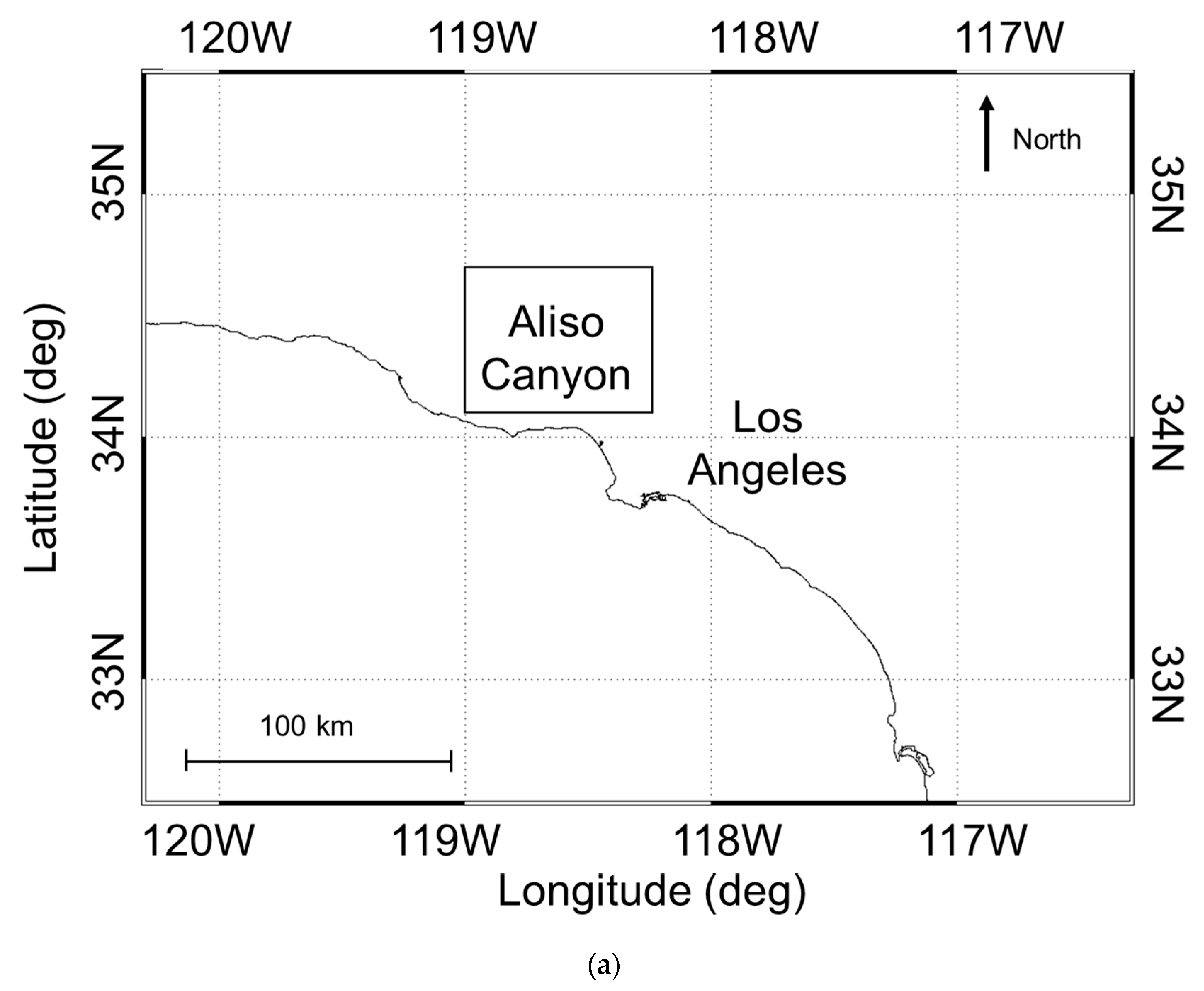
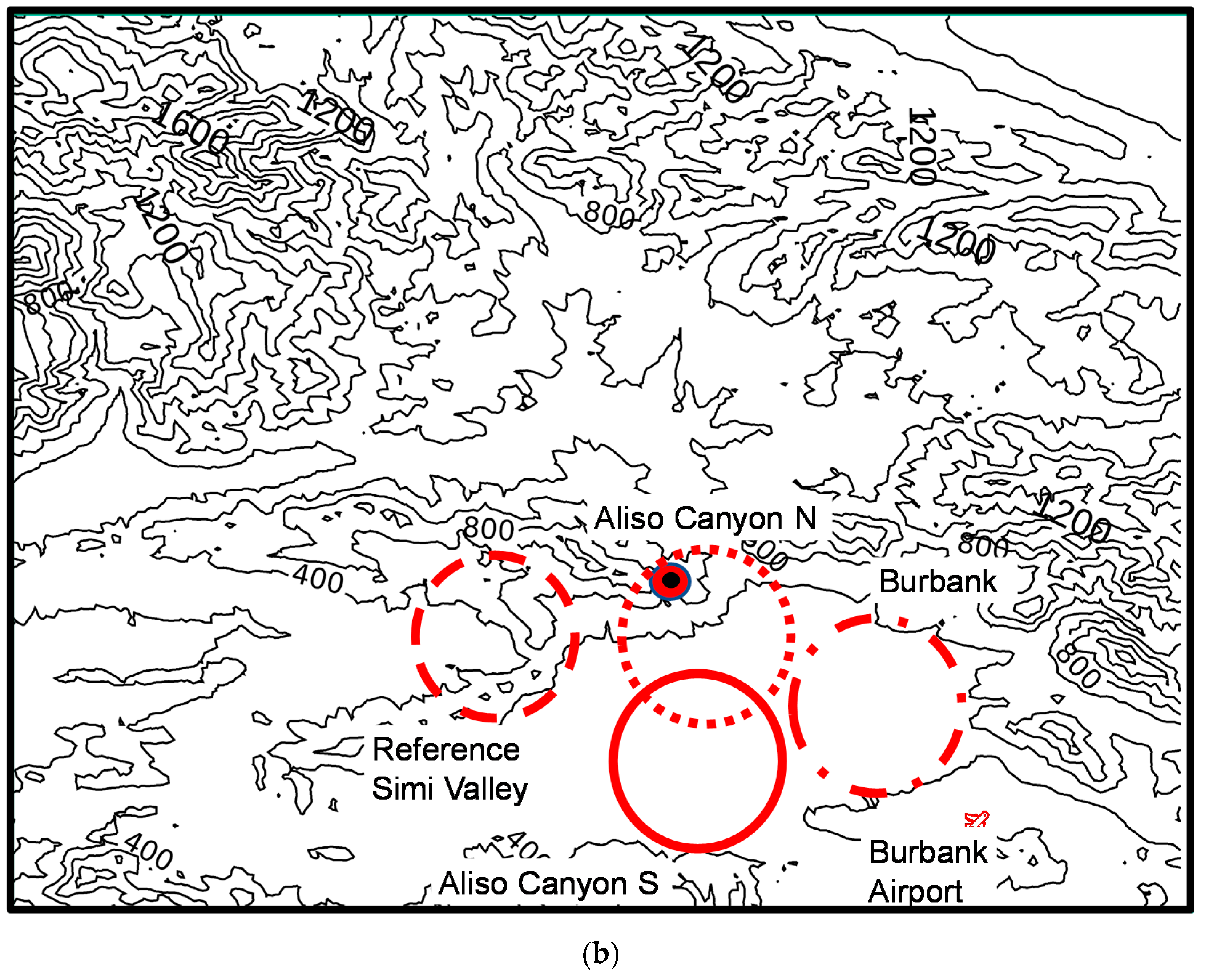

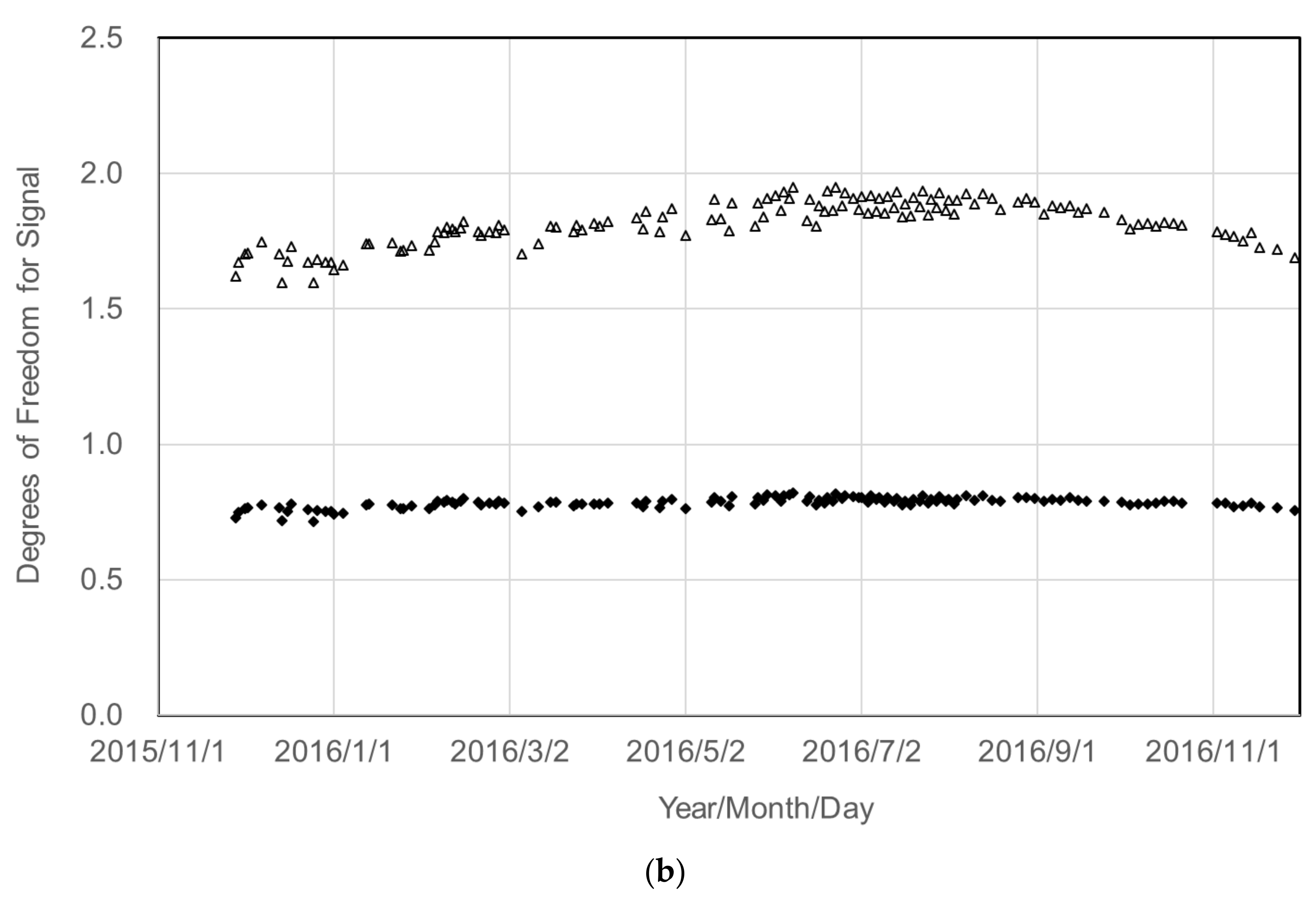


| Operation (Year) | Target | Reflected Solar Light | Thermal Emission | Pointing | Footprint | ||
|---|---|---|---|---|---|---|---|
| CO2 | CH4 | ||||||
| SCIAMACHY | 2002–2012 | ✓ | ✓ | ✓ | Entire surface | ||
| GOSAT | 2009–now | ✓ | ✓ | ✓ | ✓ | ✓ | Sparse |
| OCO-2 | 2014–now | ✓ | ✓ | Sparse | |||
| TanSAT | 2015–now | ✓ | ✓ | Sparse | |||
| GHGSat | 2016–now | ✓ | ✓ | ✓ | Sparse | ||
| TROPOMI | 2017–now | ✓ | ✓ | Entire surface | |||
| OCO-3 | 2019–now | ✓ | ✓ | ✓ | Sparse | ||
| AIRS | 2002–now | ✓ | ✓ | ✓ | Entire surface | ||
| TES | 2004–now | ✓ | ✓ | Sparse | |||
| IASI | 2006–now | ✓ | ✓ | Entire surface | |||
| CrIS | 2011–now | ✓ | ✓ | Entire surface | |||
| Type of Orbit | Sun-Synchronized Sub-Recurrent Orbit | |
|---|---|---|
| Altitude of Orbit | 666 ± 0.6 km | |
| Local solar time | 13:00 ± 15 min | |
| Pointing mechanism | Cross track | ±35° |
| Along track: | ±20° | |
| Spectrometer | Type of interferometer | Double pendulum |
| Maximum optical path difference | ±2.5 cm (both sides) | |
| Aperture | 68 mm | |
| Scan speed (one way) | 4 s/Interferogram | |
| Interferogram acquisition | Both directions (forward and reverse scans) | |
| Instantaneous field of view | 15.8 mrad (10.5 km on the ground at nadir) | |
| Band 1 | Band 2 | Band 3 | Band 4 | |
|---|---|---|---|---|
| Spectral range (cm−1) | 12,900–13,200 | 5800–6400 | 4800–5200 | 700–1800 |
| Number of Linear polarization bands | 2 | 2 | 2 | N/A |
| Spectral resolution for P polarization (cm−1) * | 0.367 | 0.258 | 0.262 | N/A |
| Spectral resolution for S polarization (cm−1) * | 0.356 | 0.257 | 0.263 | N/A |
| Sampling interval (cm−1) | 0.2 | |||
| Detector | Si | InGaAs | InGaAs | PC-MCT |
© 2020 by the authors. Licensee MDPI, Basel, Switzerland. This article is an open access article distributed under the terms and conditions of the Creative Commons Attribution (CC BY) license (http://creativecommons.org/licenses/by/4.0/).
Share and Cite
Kuze, A.; Kikuchi, N.; Kataoka, F.; Suto, H.; Shiomi, K.; Kondo, Y. Detection of Methane Emission from a Local Source Using GOSAT Target Observations. Remote Sens. 2020, 12, 267. https://doi.org/10.3390/rs12020267
Kuze A, Kikuchi N, Kataoka F, Suto H, Shiomi K, Kondo Y. Detection of Methane Emission from a Local Source Using GOSAT Target Observations. Remote Sensing. 2020; 12(2):267. https://doi.org/10.3390/rs12020267
Chicago/Turabian StyleKuze, Akihiko, Nobuhiro Kikuchi, Fumie Kataoka, Hiroshi Suto, Kei Shiomi, and Yutaka Kondo. 2020. "Detection of Methane Emission from a Local Source Using GOSAT Target Observations" Remote Sensing 12, no. 2: 267. https://doi.org/10.3390/rs12020267




